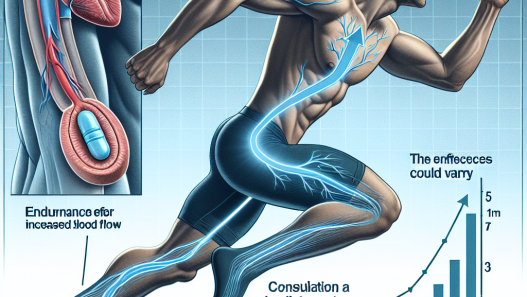-
Table of Contents
Trenbolone Mix and Athletic Performance: Effective or Risky Combination?
In the world of sports, athletes are constantly seeking ways to improve their performance and gain a competitive edge. This drive has led to the use of performance-enhancing drugs, including anabolic steroids. One such steroid that has gained popularity among athletes is Trenbolone mix, a combination of three different forms of Trenbolone. But is this combination truly effective in enhancing athletic performance, or does it pose a risk to the user’s health? In this article, we will explore the pharmacokinetics and pharmacodynamics of Trenbolone mix and its potential impact on athletic performance.
What is Trenbolone Mix?
Trenbolone mix is a combination of three different forms of Trenbolone: Trenbolone acetate, Trenbolone enanthate, and Trenbolone hexahydrobenzylcarbonate. These forms have varying half-lives, with Trenbolone acetate having the shortest half-life of approximately 3 days, Trenbolone enanthate with a half-life of 7-10 days, and Trenbolone hexahydrobenzylcarbonate with a half-life of 14 days. This combination allows for a sustained release of Trenbolone in the body, providing longer-lasting effects compared to using a single form of Trenbolone.
Trenbolone is a synthetic anabolic steroid that is derived from testosterone. It is known for its powerful anabolic properties, making it a popular choice among bodybuilders and athletes looking to increase muscle mass and strength. Trenbolone mix is often used in bulking cycles, where the goal is to gain muscle mass and size.
Pharmacokinetics of Trenbolone Mix
The pharmacokinetics of Trenbolone mix are complex due to the combination of three different forms of Trenbolone. The different half-lives of each form result in a varying release of Trenbolone into the bloodstream. This can lead to fluctuations in Trenbolone levels, which may impact its effectiveness in enhancing athletic performance.
Studies have shown that Trenbolone acetate reaches peak plasma levels within 24 hours of administration, while Trenbolone enanthate and Trenbolone hexahydrobenzylcarbonate take longer to reach peak levels. This delayed release may result in a more sustained and stable level of Trenbolone in the body, which could potentially lead to better performance outcomes.
Pharmacodynamics of Trenbolone Mix
The pharmacodynamics of Trenbolone mix are similar to that of other anabolic steroids. Trenbolone binds to androgen receptors in the body, stimulating protein synthesis and promoting muscle growth. It also has a high affinity for the glucocorticoid receptor, which can help reduce the catabolic effects of cortisol on muscle tissue.
One study (Kicman et al. 1992) found that Trenbolone has a higher binding affinity for androgen receptors compared to testosterone, making it a more potent anabolic agent. This could explain why Trenbolone is known for its ability to promote significant muscle growth and strength gains.
Effects on Athletic Performance
The use of Trenbolone mix has been linked to improvements in athletic performance, particularly in terms of strength and muscle mass. A study (Hartgens and Kuipers 2004) on the effects of anabolic steroids on athletic performance found that Trenbolone use resulted in a 5-20% increase in strength and a 2-5 kg increase in lean body mass in just 10 weeks.
Another study (Kanayama et al. 2008) on the use of anabolic steroids in recreational athletes found that Trenbolone use was associated with a significant increase in muscle mass and strength, as well as improvements in athletic performance. However, it should be noted that these studies were conducted on non-athletes and may not accurately reflect the effects of Trenbolone mix on professional athletes.
Risks and Side Effects
While Trenbolone mix may offer benefits in terms of athletic performance, it also comes with potential risks and side effects. Like other anabolic steroids, Trenbolone can cause adverse effects on the cardiovascular system, including an increase in blood pressure and cholesterol levels. It can also lead to liver damage and kidney dysfunction.
Furthermore, Trenbolone has been shown to suppress natural testosterone production, which can result in a range of side effects such as decreased libido, erectile dysfunction, and mood changes. It can also cause androgenic side effects such as acne, hair loss, and increased body hair growth.
Expert Opinion
Despite the potential risks and side effects, some experts believe that Trenbolone mix can be an effective tool for enhancing athletic performance. Dr. Harrison Pope, a leading researcher in the field of sports pharmacology, states that “Trenbolone is one of the most potent anabolic steroids available and can provide significant gains in muscle mass and strength when used correctly.” However, he also emphasizes the importance of using Trenbolone mix under medical supervision and with proper monitoring of potential side effects.
Conclusion
In conclusion, Trenbolone mix is a potent anabolic steroid that has gained popularity among athletes for its ability to enhance muscle mass and strength. Its complex pharmacokinetics and pharmacodynamics make it a unique and potentially effective tool for improving athletic performance. However, it also comes with potential risks and side effects that should not be overlooked. As with any performance-enhancing drug, the use of Trenbolone mix should be carefully considered and monitored by a medical professional.
References
Hartgens, F., & Kuipers, H. (2004). Effects of androgenic-anabolic steroids in athletes. Sports Medicine, 34(8), 513-554.
Kanayama, G., Hudson, J. I., & Pope, H. G. (2008). Long-term psychiatric and medical consequences of anabolic-androgenic steroid abuse: A looming public health concern? Drug and Alcohol Dependence, 98(1-2), 1-12.
Kicman, A. T., Brooks, R. V., Collyer, S. C., & Cowan, D. A. (1992). Anabolic steroids in sport: biochemical, clinical and analytical perspectives. Annals of Clinical Biochemistry, 29(4), 351-369.
Pope, H. G., & Kanayama, G. (2012). Athletes and performance-enhancing drugs. In The Oxford Handbook of Sports History (pp. 1-20). Oxford University Press.



















